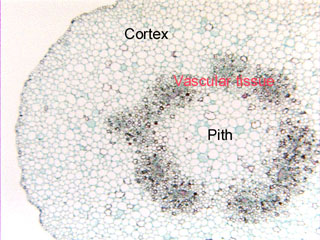 Fig.
11.1-4. Transverse section of Indian-pipe (Monotropa).
Indian-pipe is a parasitic plant that spends most of its life underground,
drawing nutrients from the roots of a host plant. The only stem that it makes is
this one that pushes up through the soil and displays flowers in a position
above ground where they are visible to pollinators. The stem is extremely
ephemeral (that it, it lasts only briefly), dying as soon as the flowers have
matured into fruits and released their seeds. Although it must be a vertical
shoot, the strength
that holds it upright is supplied by the surrounding soil, not by either
collenchyma or sclerenchyma. This stem
is very lightly constructed, consisting almost entirely of parenchyma. There is
not even much vascular tissue – the flowers are almost completely formed by
the time the stem begins its upward push, and the vascular tissues really have
little function except to supply water and nutrients as the small fruits and
seeds form.
Fig.
11.1-4. Transverse section of Indian-pipe (Monotropa).
Indian-pipe is a parasitic plant that spends most of its life underground,
drawing nutrients from the roots of a host plant. The only stem that it makes is
this one that pushes up through the soil and displays flowers in a position
above ground where they are visible to pollinators. The stem is extremely
ephemeral (that it, it lasts only briefly), dying as soon as the flowers have
matured into fruits and released their seeds. Although it must be a vertical
shoot, the strength
that holds it upright is supplied by the surrounding soil, not by either
collenchyma or sclerenchyma. This stem
is very lightly constructed, consisting almost entirely of parenchyma. There is
not even much vascular tissue – the flowers are almost completely formed by
the time the stem begins its upward push, and the vascular tissues really have
little function except to supply water and nutrients as the small fruits and
seeds form.